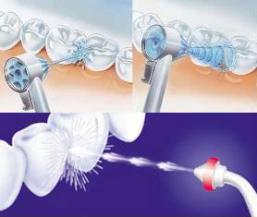Oral Irrigator - Also Called a Dental Water Jet

Oral irrigators or water jets work by using pressured water or mouthwash to dislodge biofilm (plaque) from gaps between the teeth, around the gum margin and into periodontal pockets. An oral irrigator can also be used on orthodontic appliances and people who have crowns and bridges.
Oral irrigators were first invented as an alternative to dental flossing as many people found it difficult to use floss as they could not reach areas in the back of the mouth. This led to people flossing infrequently and subsequently plaque biofilm would build up on their teeth.
It is the build up of biofilm from remaining food particles in the mouth that contributes to dental cavities, bad breath and gum disease.
There are two main benefits of using an oral irrigator.
Firstly, the device is an easy and effective way of cleaning your teeth as the water streams can reach far back into the mouth and in-between the teeth themselves. This is because the handles on irrigators are ergonomically designed and they have angled nozzles which allow you to access all areas of the mouth. And, you do not need to use irrigators for a long period of time before they are effective.
Just a 60 second blast is enough to clean teeth in all areas of the mouth. Secondly, studies have shown that by using an irrigator along with your daily brushing twice a day, you can remove 99% more plaque than if you only used a manual toothbrush. And further research suggests that using an irrigator improves gum health by up to 93%, compared to brushing alone. It also helps to significantly reduce gingivitis and calculus after only 2 – 4 weeks of use.

It is thought that it is the pulsating action of an irrigator that is key to what helps clear dental debris and food particles. Although the streams of water are gentle and un-invasive, the powerful and targeted action of the water jets does work well to disrupt the most difficult to reach areas of the mouth.
By using a powerful miniature pump to send pulsating streams of water through a plastic tip to clean the teeth, debris is efficiently swept away from over, between and under the teeth and at the same time works to stimulate gum tissue.
By incorporating a regime where you use an irrigator to first remove biofilm and food debris, you are ensuring that your teeth are effectively plaque free before you progress to brushing with fluoride toothpaste.